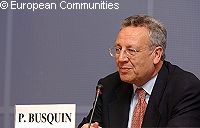Busquin presents examples of EU funded mass research collaboration
At the 'Communicating European Research' conference on 11 May, which marked the launch of 200 new Networks of Excellence and Integrated Projects, Research Commissioner Philippe Busquin expressed the hope that these new Sixth Framework Programme (FP6) instruments would enable Europe to move to a higher level in research. 'It is something that is very close to my heart,' he said, 'to optimise the efforts of our researchers who are among the best in the world.' Mr Busquin presented two specific projects, Ga2Len and Seafood plus, and called for less fragmentation in European research. The first project, SEAFOODplus, is the largest research project ever sponsored by the EU in the seafood sector, with a contribution of 14.4 million euro over four and a half years. An Integrated Project, SEAFOODplus involves 70 partners from 16 European countries and Canada, and aims 'to reduce health problems and to increase well-being among European consumers by applying the benefits obtained through consumption of health-promoting and safe food products of high quality,' explained professor Torger Børresen, the project coordinator. The objective of the project is to increase fish consumption in Europe by increasing public trust and demonstrating the positive role of fish in addressing health problems. Indeed, studies have shown that fish consumption helps reduce chronic diseases such as colon cancer, as a well as obesity, osteoporosis and depression. Research will focus on tailor-made products, better use of by-products, ethical fish farming and aquaculture, and developing a validated treacability system. Professor Børresen explained that this project is unique in that never before have researchers from such different scientific areas worked so closely at European level. 'Seafood is a project, which, with the idea of avoiding the fragmentation of European research, brings together researchers in medicine and nutrition, food safety, food technology and consumer studies,' emphasised Mr Busquin. The Commissioner also congratulated the project team for its efforts to include small and medium sized enterprises (SMEs). Professor Børresen added that a specific section of the budget is devoted to increasing the percentage of industry partners 'as it is expected that the research results will be put to commercial use afterwards,' he said. Presenting the second project Ga2Len, a Network of Excellence for allergy and asthma, Mr Busquin explained that, due to the increase of allergies and asthma in Europe, 'it is important to avoid the scattering of research efforts and instead collect information and competencies in a Network of Excellence.' Ga2Len brings together 27 partners from 15 countries and, with an EU contribution of 14.4 million euro over five years. It aims to address allergy and asthma as a global health problem, integrate the research data of the partners, create a permanent structure to maximise the scientific contribution of Europe to allergy and asthma understanding, and to decrease the worldwide burden of allergies and asthma, explained Professor Paul Van Cauwenberge, the project coordinator. Ga2Len will develop and disseminate evidence-based guidelines on prevention and treatment for the public, the press, healthcare providers and policy makers



